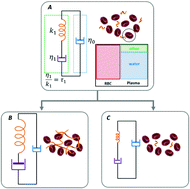Passive high-frequency microrheology of blood†
Abstract
Indicative of various pathologies, blood properties are under intense scrutiny. The hemorheological characteristics are traditionally gauged by bulk, low-frequency indicators that average out critical information about the complex, multi-scale, and multi-component structure. In particular, one cannot discriminate between the erythrocytes contribution to global rheology and the impact of plasma. Nevertheless, in their fast stochastic movement, before they encounter each other, the erythrocytes probe the subtle viscoelasticity of their protein-rich environment. Thus, if these short time scales can be resolved experimentally, the plasma properties could be determined without having to separate the blood components; the blood is practically testing itself. This microrheological description of blood plasma provides a direct link between the composition of whole blood and its coagulability status. We present a parametric model for the viscoelasticity of plasma, which is probed by the erythrocytes over frequency ranges of kilohertz in a picoliter-sized volume. The model is validated both in vitro, using artificial hemo-systems where the composition is controlled, as well as on whole blood where continuous measurements provide real-time information. We also discuss the possibility of using this passive microrheology as an in vivo assay for clinically relevant situations where the blood clotting condition must be observed and managed continuously for diagnosis or during therapeutic procedures at different stages of hemostatic and thrombotic processes.



 Please wait while we load your content...
Please wait while we load your content...